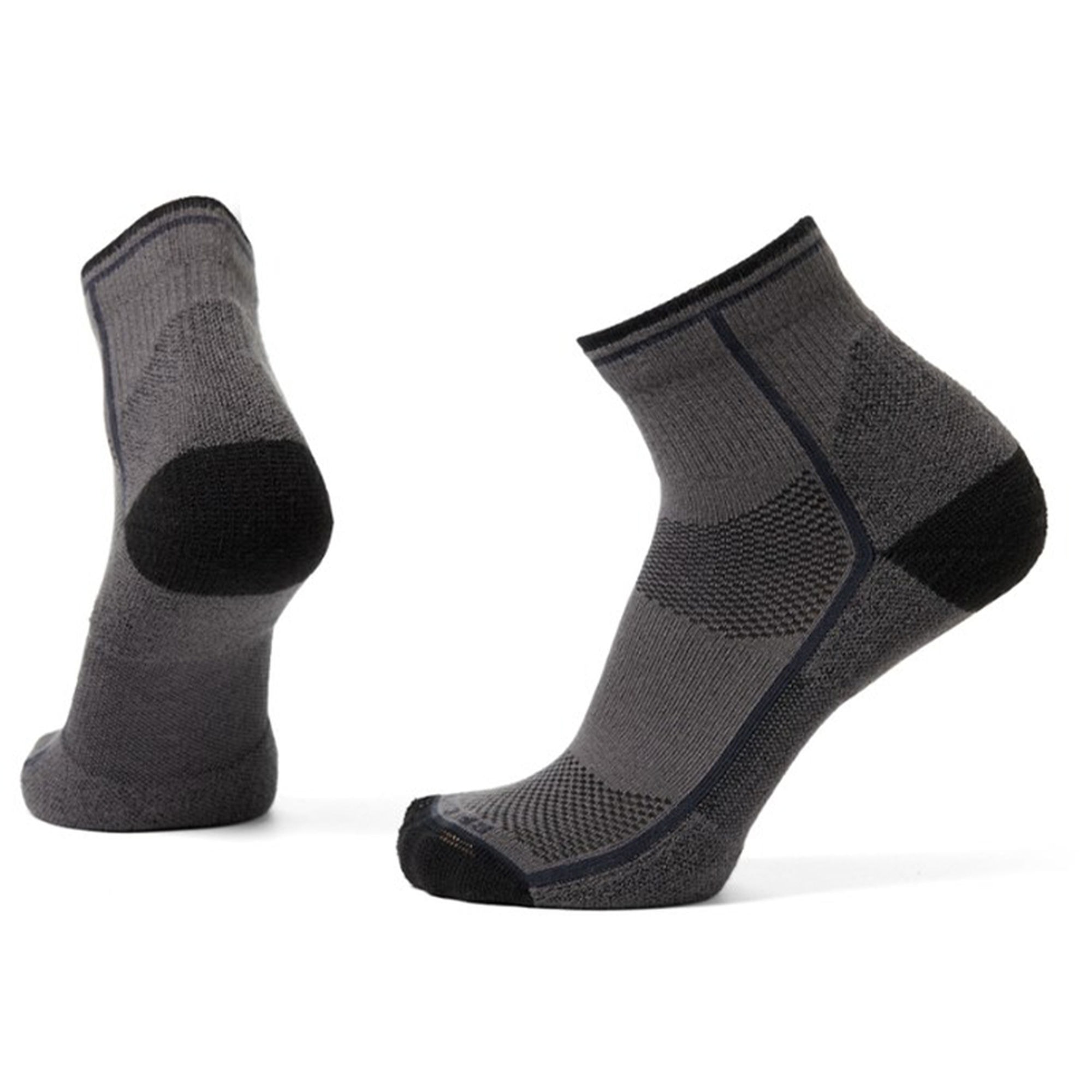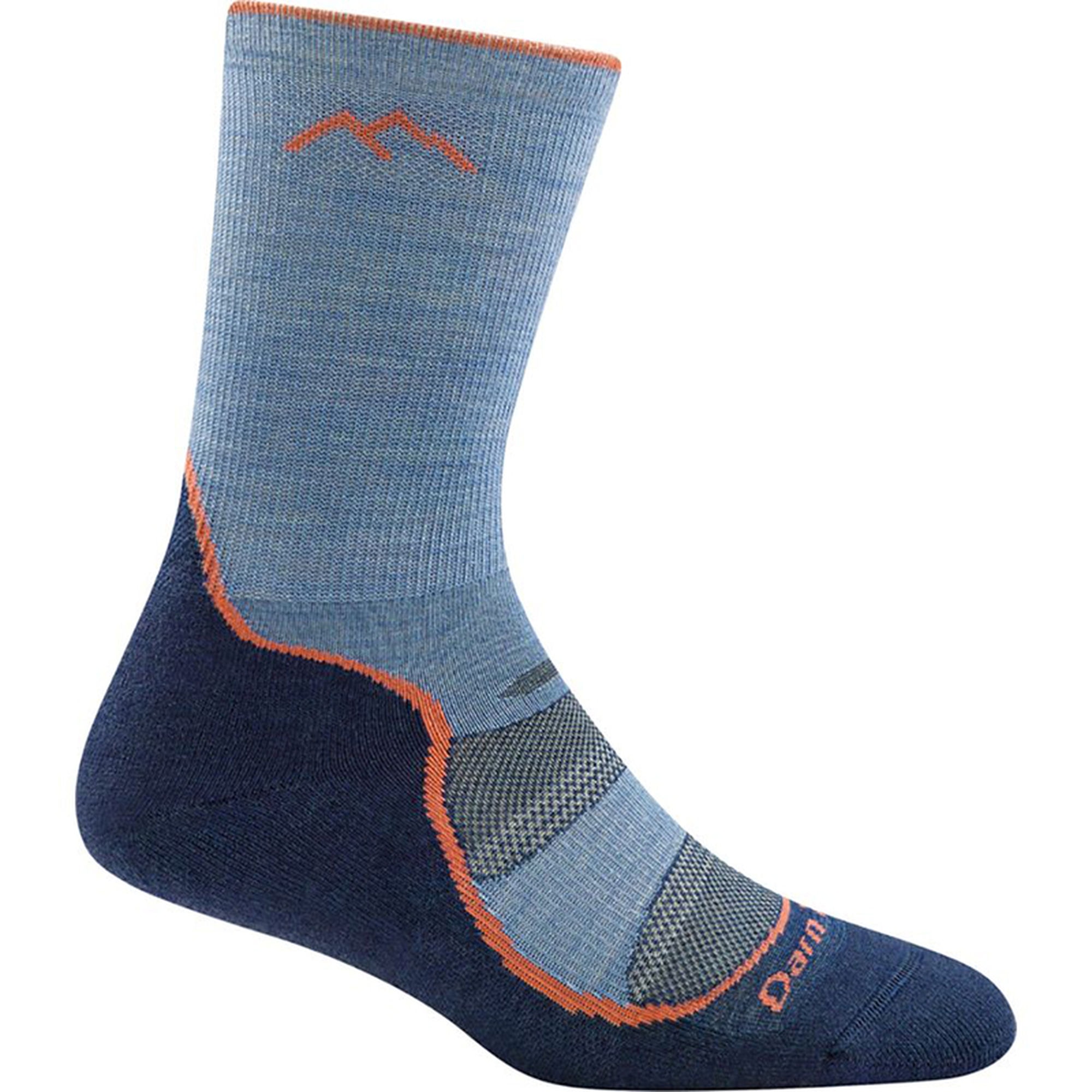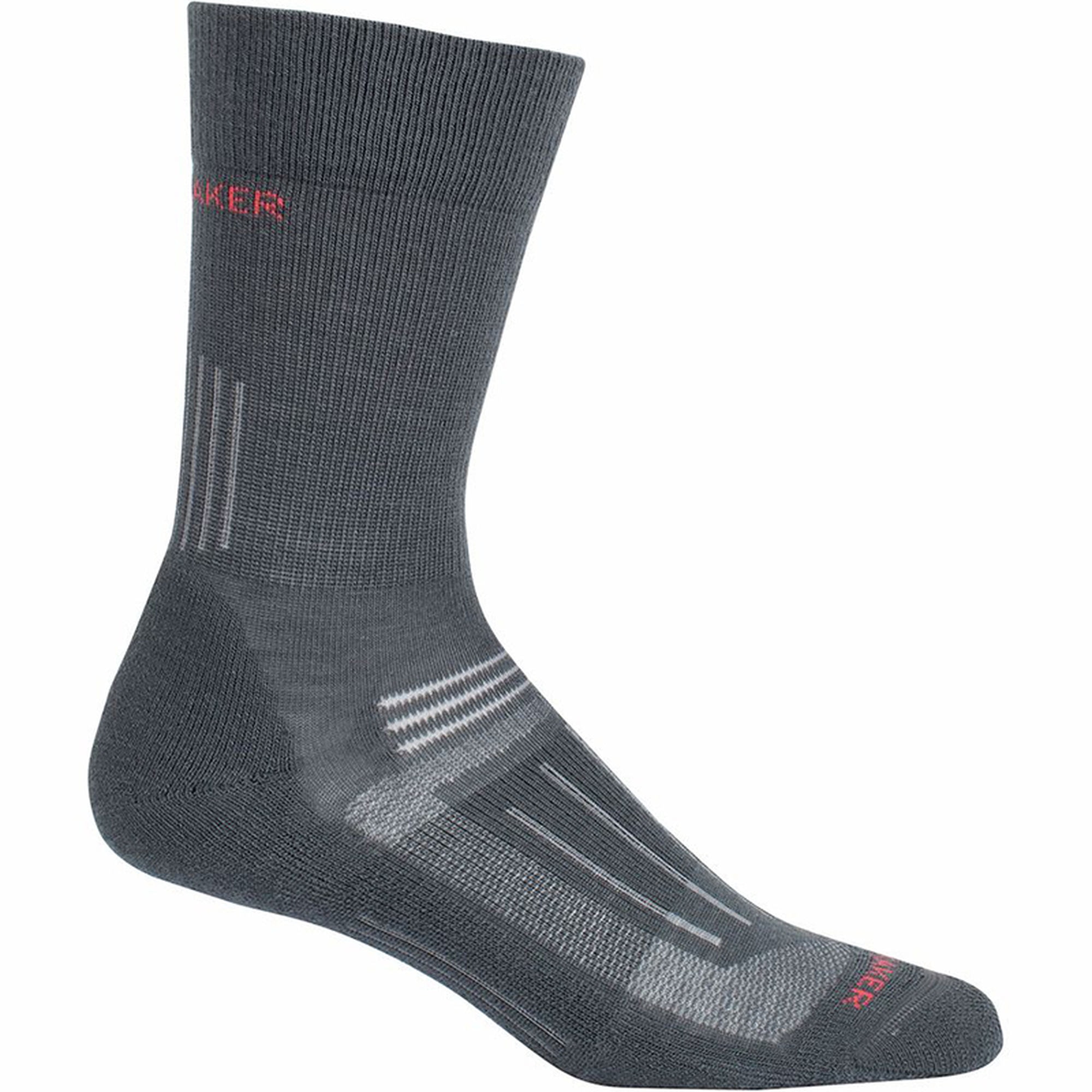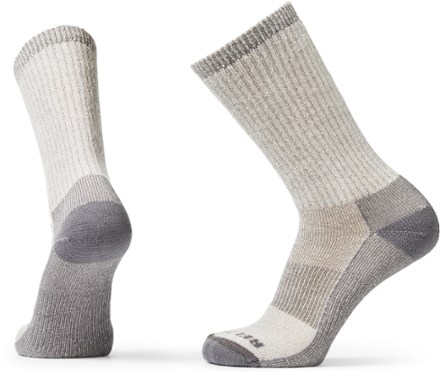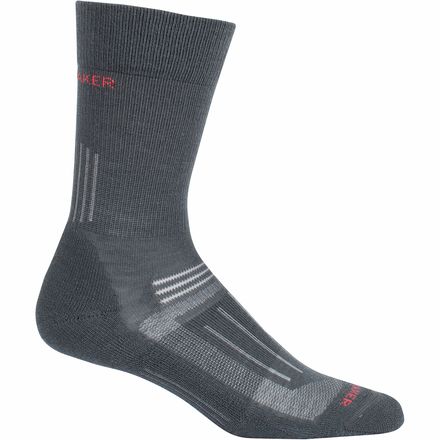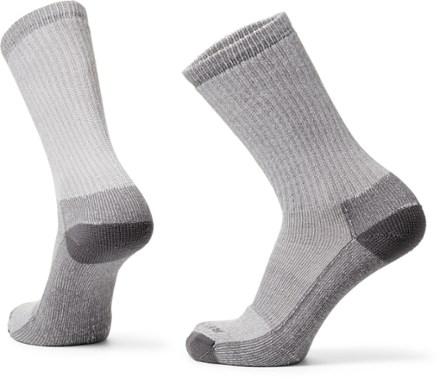Hiking socks (right alongside boots) are one of the most important pieces of outdoor apparel. Hot spots and blisters are painful beyond reason (like paper cuts—so little, yet so much OUCH!) and will make you more uncomfortable with every passing step. Sweaty, wet feet and cold toes can also seriously slow you down on the trails.
Depending on how many miles you’re logging, it’s normal to feel some aches and pains in your hardworking feet, but the right pair of hiking socks can alleviate the worst troubles. Investing in high-quality hiking socks will pay off in dividends after hours of pounding rocky trails, navigating uneven terrain, and even conquering a river crossing or two.
Things to consider when looking for hiking socks include:
- Material — durability, washability, fabric strength, breathability, and moisture-wicking capabilities
- Comfort — cushioning and weight/warmth
- Height — function (and let’s be honest, fashion)
Material
Breathable, moisture wicking, quick drying, and odor resistant. This is what you want in a hiking sock. All of which is indicated by what it’s made with and directly impacts to the sock’s quality and durability.
A few things to know:
Can’t do cotton
Cotton is not your friend when you’re out on the trails. Let’s just get that out of the way. Leave your everyday socks back at camp or at home. Rather than releasing and wicking moisture, as your feet start to sweat, cotton holds it in, which causes blisters and chafing.
It can also make your feet stay wetter longer, which can lower your body’s core temperature, which can be quite dangerous if it’s just slightly cold outside. While cotton is soft and comfy—so you may find some in hiking socks—you definitely do not want a 100% cotton sock for any outdoor activity.
Wool is the way to go
As a highly breathable material, wool actually helps regulate your body temperature better than synthetic materials, cooling you down even before you start sweating.
But not all wool is created equal. You’ll find it in a lot of hiking socks, but the quality of the wool matters more than the percentage of how much is used. High-quality merino wool is used in all sorts of outdoor apparel—namely base layers for warmth—because of its incredible ability to keep you warm even as it gets wet by wicking away moisture.
Merino is softer than traditional wool, and worth every penny more than cotton. It is a natural material that can handle moisture and also helps odors escape. When blended with a few synthetics, this is going to be your best bet for outdoor protection.
Synthetics are smart
Synthetic materials like nylon, spandex, polyester, etc. are made to breathe, repel sweat and moisture, and dry in an instant. When combined with natural fabrics like wool, synthetics create a bit more comfort and also help to prolong the life of your outdoor gear, all the while delivering these important technical aspects you’ll appreciate outdoors.
Weight/thickness/comfort
Hiking socks are made with extra cushioning in strategic places to provide added support for hours on your feet. This is especially helpful around the heel when going uphill and the toe for downhill treks. Bands of support around the calf and arch help keep the sock in place while you’re on the go, which we all can agree is extremely important. There’s nothing worse than a slipping sock!
The thicker the sock, the better protection during colder temperatures. No brainer. So it’s a good idea to have thinner summer socks and pull out the thicker hiking socks for winter. Or, if you’ve got a long journey ahead and can use a little extra loving.
Don’t forget that the thickness also impacts the fit and how tight your boots will be, so remember to size up when purchasing boots and always try them on with a substantial pair of hiking socks.
There are a few degrees of thickness/cushioning you’ll notice as you’re shopping for hiking socks:
Ultralight/no cushioning — best for warm and hot weather
Some lightweight socks are also called liners and can be worn under a pair of thicker hiking socks to further prevent blisters. Many hikers also wear them on their own for trail running or warm-weather hiking. I tend to pick the most minimal pair of socks I can get away with, so this is my go-to for short hikes. I find them more comfortable and free-moving than thicker socks, but adding cushion can be a real game changer.
Light cushioning — works well in most weather conditions
These are still relatively thin hiking socks but will provide a bit extra cushion where it matters most: on the heel and ball of the foot. This added support also lends these socks a bit more durability than the thinner options. Lightweight hiking socks are still very breathable and great at wicking away moisture.
Medium cushioning — can be used in warm to cool temperatures
This is the most popular style for most serious hikers who plan to log a few hours at a time out on the trails. These are versatile socks that can be worn in warm or chilly weather. They’re still very breathable and help to moisture wicking, though less so than thinner socks.
Heavy cushioning — best for heavy duty hiking and/or colder weather conditions
A heavy duty pair of hiking socks might be necessary if you’re hiking or backpacking in cold temperatures or doing any serious mountaineering. I sometimes also wear mine skiing, since they’re knee-high. They are bulky, so make sure your boots fit comfortably, and definitely include a liner sock to keep it all in place.
Height
This is a personal choice to some degree. You definitely want a hiking sock that clears the height of your boot—whatever that may be—keeping your shoe from rubbing directly on your skin.
If you’re wearing shorts, higher socks can protect you from scraping brush out on the trail and keep loose pebbles or rocks from getting into your socks. And, they’re less likely to slip into the boot and bunch up at your ankle.
However, there are some great ankle-length hiking socks that do stay put if you’re going for a short hike on a hot day and prefer this style.
Micro/no show/no show tab
These socks are the most minimal, barely clearing the ankle of the shoe. These are best to wear with lightweight trail running shoes. These socks are the most lightweight but can slip down, allowing debris to get inside your sock, and leaving you prone to heel clipping (we all have those friends) and cuts around the ankle. Stylish, but maybe not the most practical.
Quarter/ankle
These are the socks your dad probably wears, coming just over the ankle. They may not be the most fashionable, but they sure are functional, staying put without sliding down and keeping trail debris out of your sock.
Micro crew/mini crew/mid crew
A few inches shorter than traditional crew.
Crew
This is your classic hiking sock height that comes to somewhere around mid-calf. The exact height will vary by brand. Crew hiking socks are ideal for various boot heights, providing a bit more protection from the trail by covering your shins. They’re also going to keep you a little warmer, so great for spring or fall hiking when the temps are cooler.
Knee-high
Over-the-calf hiking socks are ideal for keeping warm in winter. Certain styles also act as a compression sock to help combat swelling.
For the fit, you want a snug sock that stays put on your foot. Snug, but not too tight.
Value
These high-quality hiking socks are going to cost a bit more than traditional socks—somewhere in the ballpark of $20 per pair—and that’s for good reason. They are built to withstand lots of use and log miles on the trails, with the best materials and technical aspects that provide comfort. At the end of the day, a couple extra bucks will go a long way when it comes to hiking socks.
How this list was chosen
Several of these hiking socks I own and can personally attest to in these categories above. Others are highly rated on REI, Backcountry, and Amazon. They’ve been tried and tested for countless miles out on the trails, and I’ve poured over reviews to showcase helpful insights here, helping you decide which sock is the best for you personally.
Darn Tough Light Hiker Micro Crew
Height: no show and micro crew
Cushioning: light (shown here) and medium
Material: 54% nylon, 43% breathable merino wool, 3% Lycra spandex
This is one of the most popular hiking socks out there for its comfort and breathability. It’s also a tight fit, so won’t move around or bunch up inside your boot. It’s also versatile, great for hiking in varying temperatures, so you’ll be covered from spring through fall.
With fast-wicking protection, your feet won’t feel sweaty, and the wool keeps them from accumulating unwanted odors. Added arch support and underfoot padding for optimal comfort.
Lifetime guarantee means you can replace them for free—no questions asked—anytime. That’s worth the few extra bucks if you ask me.
REI Merino Wool Lightweight Hiking Crew Socks
Height: crew (shown here) and ankle/quarter socks
Cushioning: also available in liners, ultralight ankle, ultralight crew, and midweight crew
Material: 79% Responsible Wool Standard merino wool, 20% nylon, 1% Lycra spandex
A bit less expensive than some of the other mainly-merino wool hiking socks on this list, REI’s lightweight crew socks are its most popular for summers out on the trails. At 79% merino wool, they’re very breathable, odor-resistant, moisture-wicking, and quick-drying.
This sock has several reinforcements for long-lasting protection, including the heel, toe, footbed and Achilles.
Responsible Wool Standard means that the sheep are treated in accordance with leading animal welfare standards, so you can sleep well at night knowing no sheep suffered for your comfort.
Icebreaker Hike + Lite Crew
Height: crew (shown here) and ankle/mini crew
Material: 65% merino wool, 32% nylon, 3% Lycra
These are one of the thinnest socks on the list, great for heavy feet sweaters (raises hand), yet still very durable and will not wear out. If they do, return them. All Icebreaker socks come with a lifetime manufacturer warranty. When you’ve worn them out, simply swap them in for a new pair—no questions asked.
The highly breathable soft knit stays in place after hours on the trail. The seamless toe closure reduces bulk while preventing blisters, and reinforced merino cushioning on the heel and metatarsal bones increase comfort. With several technical aspects, the socks are labeled R and L, so you know they’re paying attention to detail.
Smartwool PhD Outdoor Light Micro
Height: micro (shown here), mini, midcrew, and crew
Cushioning: also available in medium crew
Material: 60% merino wool, 38% nylon, 2% elastane
These win in the best no-show hiking sock category. Smartwool has been dominating the outdoor sock category for years—also selling cycling, running, skiing, and snowboarding socks—making some of the most comfortable and highly functioning apparel. They were the first company to make performance merino wool ski socks, which I love.
These socks clock in a 2″ high and will stay put on your heel while you hike with a flex zone at the ankle to aid in movement. The thermoregulating technology keeps you cool when it’s warm and warm when it’s cool. The light cushioning provides just enough support and padding for light, everyday hikes.
REI COOLMAX EcoMade Lightweight Hiking Crew Socks
Height: crew (shown here) and quarter/ankle
Cushioning: also available in liners, ultralight quarter, ultralight crew, midweight quarter, and midweight crew
Material: 77% COOLMAX EcoMade polyester, 22% nylon, 1% spandex
REI is known to offer great value. Its products might not be the most technical on the market, but for the price you’re paying, you’re guaranteed a still-very-high-quality piece of gear.
This is REI’s non-wool hiking sock (calling all vegans), that’s made from recycled plastic water bottles. The nylon and spandex provide ample stretch and durability.


